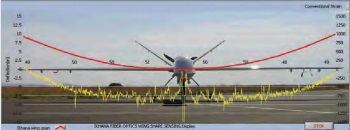Chapter: Fiber Optic Sensing, new invention technology, Research project papers,
Strain Sensing for Displacement and Two-Dimensional (2-D) Shape

Strain Sensing for
Displacement and Two-Dimensional (2-D) Shape
A gust of wind or aerial maneuvers can cause a large
displacement in the wings of a lightweight UAV during flight and is the known
cause of at least one UAV crash. Therefore, an Armstrong research team has
designed an algorithm model that uses fiber optic structural strain
measurements to determine deflection and 2-D shape. When combined with the
other elements of FOSS, this approach provides higher accuracy and higher
spatial resolution than other shape-sensing systems available. Other methods
use cameras to image wing deformation; however, these approaches require
high-speed processing systems, add weight to structures, and are less accurate
than the FOSS approach. The Armstrong methods can be implemented without
affecting performance and without the need for structural modifications.
Work to date: The technology has been used to assess
large-scale composite wings, to evaluate the Global Observer UAV,
and in Ikhana UAV flight testing, which is believed to be the first flight
validation test of fiber Bragg grating strain and wing-shape sensing. In eight
tests that logged 36 flight hours, a total of six fibers (~3,000 strain
sensors) were installed on Ikhana's left and right wings. The fiber optic and
conventional strain gauges showed excellent agreement during multiple flight
maneuvers.
Benefits
High spatial resolution: Enables measurements
approximately every 0.5 inches
Easy
application: Small enough to be used on sensitive surfaces
without affecting performance
Applications
Determining aerial
wing shapes Monitoring turbine blade shapes
Structural health
monitoring for bridges, buildings, and ships
Fiber Optic Sensing
Armstrong's portfolio of Fiber Optic Sensing System (FOSS)
technologies offers unparalleled options for high-resolution sensing in
applications that require a unique combination of high-powered processing and
lightweight, flexible, and robust sensors. The system measures real-time
strain, which can be used to determine two-dimensional and three-dimensional
shape, temperature, liquid level, pressure, and loads, alone or in combination.
Initially developed to monitor aircraft structures in flight, the system's
capabilities open up myriad new applications for fiber optics-not just in
aerospace but also for civil structures, transportation, oil and gas, medical,
and many more industries.
The Armstrong approach employs fiber Bragg grating (FBG)
sensors, optical frequency domain reflectometry (OFDR) sensing, and
ultra-efficient algo-rithms (100 samples/second). Engineers are continually
seeking new ways of looking at information and determining what is important.
Armstrong's FOSS technologies focus on critical research needs. Whether it is
used to determine shape, stress, temperature, pressure, strength, operational
load, or liquid level, this technology offers ultra-fast, reliable
measurements.
Related Topics